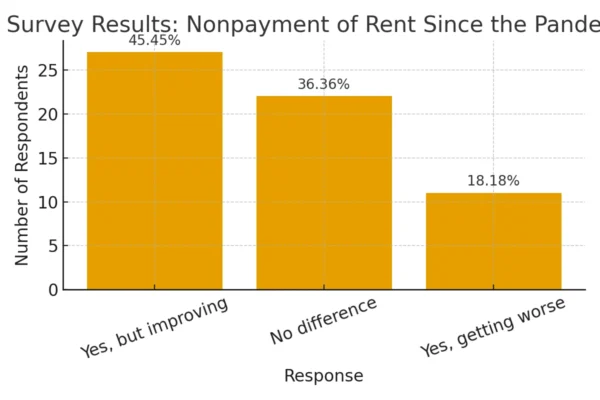The Top 10 Most Common Illegal Landlord Actions
 One of the last things a landlord or property manager wants is to be sued by a tenant. The best-case scenario is it’s a misunderstanding and doesn’t go anywhere. However, to prevent the worst-case scenario (proof of illegal landlord actions), it’s important for property owners to understand federal, state and local rental laws to ensure they’re in compliance.
One of the last things a landlord or property manager wants is to be sued by a tenant. The best-case scenario is it’s a misunderstanding and doesn’t go anywhere. However, to prevent the worst-case scenario (proof of illegal landlord actions), it’s important for property owners to understand federal, state and local rental laws to ensure they’re in compliance.
Illegal landlord actions don’t have to be malicious or purposeful. They could occur when the landlord violates a law, whether through direct tenant interactions or content in a lease agreement. Not only does each state have different landlord-tenant laws, but there may also be additional local (e.g., county or municipality) rules that must also be followed. The result? Some landlord actions that are legal in one area may be illegal in a different one.
That’s why comprehensive knowledge of common illegal landlord actions can help you understand what’s within your rights as a landlord and what should be avoided to protect your tenant and property.
Important reminder: If you have any legal questions or concerns, please reach out to an attorney or law professional. This article is purely educational and should not be construed as legal advice.
Read on to discover more about illegal landlord actions to avoid.
Landlord need-to-know: Fair Housing Act
All landlords, property managers and property management companies need to be familiar with the Fair Housing Act. According to the U.S. Department of Housing and Urban Development, this federal tenant law protects people from discrimination when they are “renting or buying a home, getting a mortgage, seeking housing assistance, or engaging in other housing-related activities.”
Specifically, discrimination based on any of the following reasons is prohibited:
- Race
- Color
- National origin
- Religion
- Sex (including gender identity and sexual orientation)
- Familial status
- Disability
Landlords must only screen prospective tenants based on legal rental screening reports (e.g., credit check, rental history, background check, proof of income, etc.). However, some reasons a landlord can refuse to rent to tenants include:
- No rental history
- History of non-payment of rent
- Pets (excluding service animals)
- Past eviction history
- Smoking
- Criminal background
The Fair Housing Act applies to most forms of housing and properties. Every property owner that plans to rent to potential tenants must comply with these requirements to ensure discrimination-free practices.
Learn more about the Fair Housing Act here.
Top 10 illegal landlord actions
Although you may own or manage the property being rented, you must ensure you’re not violating any rental laws and respect your tenant’s rights — otherwise, they may have grounds to pursue legal action.
Below are the top 10 most common illegal landlord actions you should avoid:
1. Entering the rental property without prior notice.
When you enter a rental agreement with a tenant, you lose the right to enter the rental property whenever you want due to their right to privacy. Instead, you must give advanced written notice that includes a valid justification to enter the rental unit, such as for repairs.
Verify with your area’s specific laws to determine exactly how much notice is required. Generally, it’s acceptable to give between 12 and 48 hours advance notice.
However, there is an exception to this rule. A landlord may enter an occupied rental property without notice if there’s an emergency, such as a suspected fire or gas leak. In these scenarios, landlords must still legally inform the tenant if this has happened. They can do so by leaving a written notice before leaving the property.
2. Not disclosing if the rental property contains hazards, such as lead-based paints or mold.
A landlord must inform prospective tenants whether there are potential hazards on the rental property. It’s best practice to provide written disclosure of these property risks to the potential tenants before they agree to sign the lease.
Typically, landlords and property managers choose to include the disclosures with the lease agreement to ensure that each and every tenant understands any possible risks before moving in. This allows the tenant enough time to determine if they will or will not proceed with the agreement.
If a landlord doesn’t inform tenants of potential risks, they can be held liable for any tenant health problems resulting from undisclosed hazards.
3. Mishandling the security deposit.
The two most common ways a landlord illegally mishandles tenant security deposits include:
- Using a security deposit for the wrong reasons.
- Withholding the security deposit from the tenant.
Security deposits are a protective measure for landlords that should be used to solely cover damages to the rental property that were caused by tenants. These damages can be material (water damage to the floor or a hole punched through a door) or financial (back-due rent) in most states. It’s illegal for a landlord to use the security deposit for any other purpose.
Specifically, the security deposit cannot be used to repair standard wear-and-tear — this is illegal.
Similarly, landlords cannot refuse to return the security deposit (whether it’s the full amount or the remaining amount after legal repairs) to a tenant after they move out. Unless it has been completely used to fix tenant-caused property damage, that money must be returned by the landlord.
Need help determining what constitutes normal wear-and-tear? Read through our helpful guide.
4. Retaliatory actions due to a tenant complaint.
If a tenant files a complaint against a landlord, they are legally protected from retaliation.
For landlords, this may include doing any of the following as punishment:
- Raising rent
- Refusing or delaying repairs
- Threatening the tenant
- Pursuing an eviction
- Shutting off utilities
Even if unintentional, landlords cannot take any actions that may be viewed as a negative action due to a tenant’s complaints.
5. Increasing rent without notice.
If you plan on raising rent, you must give your tenants proper notice according to your local or state legal requirements. The exact timeline for providing notice may also vary depending on if your tenant is on a yearly lease or month-to-month rental agreement. Furthermore, any rent increase cannot take effect until after the current agreed-upon lease ends.
Typically, every landlord must give around 30 to 60 days written notice to a tenant if they’re raising the rent amount. Verbal notice is not a legally acceptable way to inform your tenants. Depending on your state, you can either write a letter to your tenant or you must send a certified letter.
If you don’t follow legal protocol, the rent increase is inadmissible and unenforceable.
If you need help creating a rent increase notice, check out the AAOA how-to guide and template here.
6. Increasing rent beyond legal limits.
This illegal action mostly occurs for rent-controlled or rent-stabilized properties, which are protected by local regulations. However, there are a few states in the U.S. that put a limit on how much a landlord can raise a tenant’s rent within certain periods of time.
Always reach out to an attorney or law professional if you have any concerns about rental laws in your area or for your specific property situation.
7. Misuse or abuse of late fees.
For landlords, it’s a common practice to charge late fees if the tenants don’t pay in a timely manner — most states allow it. However, many states dictate exactly when and how a late fee can be charged to a tenant. If a landlord charges a late fee that is too high, early or excessive, they could be breaking the law.
Some states have passed laws to protect tenants from exorbitant late fees. In those areas, any late fee must be “reasonable” in proportion to the rental amount. Similarly, landlords may be required to include late fee amounts in the lease agreement.
Pre-determined grace periods have also been passed in certain states, which means a landlord cannot charge a late fee until that period has passed.
As a landlord, one way to ensure legal practices is to review your local rent laws and use them to guide your rental property’s late fee policy. This can help protect you from liability or legal action.
Utilize the AAOA late rent notice form if your tenant has defaulted on their lease agreement.
8. Failing to do required inspections for your rental property.
A rental property must be habitable for tenants. To ensure this, landlords are required by law to conduct certain inspections of the rental property. Some examples of potentially required inspections include:
- Fire inspections (e.g., smoke detectors, carbon monoxide detectors, etc.)
- Move-in and move-out inspections
- Housing Code inspections
- Safety inspections
- Routine inspections
Every landlord should want their rental property to be both legally safe and habitable. By following state or city-mandated inspections, you can ensure that each rental is in compliance.
9. Avoiding or refusing necessary repairs.
A tenant has a right to privacy and the right to a safe home. This means that every landlord is legally required to handle repairs in a timely manner for their tenants.
If any part of the home breaks, it’s up to the landlord to handle the repairs — not the tenant. If the landlord tries to push the responsibility onto the tenant, they’re breaking the law.
They must either fix the problem themselves or hire a licensed contractor that can get the job done. However, the tenant may still be able to pursue legal action if the landlord doesn’t pursue repairs in a reasonable amount of time, as determined by the local area’s rental laws.
Having a rental property with broken-down appliances or required repairs is a headache, so it’s in the best interests of the landlord and tenant to get these repairs completed as soon as possible.
10. Forcefully removing or locking out tenants without an eviction order.
There are many reasons a landlord can pursue eviction for their tenants. From breaking the lease agreement to nonpayment of rent, it’s well within a landlord’s right to evict.
However, no landlord can forcefully evict a tenant without first taking them to court and following the proper legal procedures. Without a court order, tenants cannot be prevented from accessing the rental property. This includes by physical force or by changing the locks to the rental unit.
This may be frustrating, especially if the current tenants are disturbing other residents, but every landlord must take the tenant to court and successfully obtain an eviction order to remove tenants from the property. No other actions can be taken to prevent access to the property until then.
Get started with AAOA today
Ready to streamline and optimize the various responsibilities of rental property management? Improve your landlord practices with AAOA’s broad range of resources, including tenant screening services, tenant background checks and a comprehensive library of landlord-tenant laws for every U.S. state — which you can access at any time.
Looking for additional resources for landlords? AAOA offers industry-leading services and materials to help you make the most informed decision possible.
The information provided herein is for advisory purposes only and AAOA takes no responsibility for its accuracy. AAOA recommends you consult with an attorney familiar with current federal, state and local laws.













 Accessibility
Accessibility